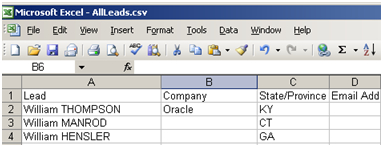Importing data
Importing data is an easy way to add new records, update or delete existing records in bulk, or create new objects and add records for them. You can import data from spreadsheets and comma-separated value (CSV) files. For existing objects, the Import option is available from the page menu. You can also configure list views to display an import link in the section header using the Page Editor. For creating new objects and associated records, see Importing to create a new object.
Note the following before attempting an import:
- Spreadsheets must be saved in .xls or .xlsx format.
- The file to be imported cannot exceed 1MB. For Platform Private Cloud customers, the maximum file size is configurable.
- Only data on the first worksheet of spreadsheet files will be imported.
- Platform assumes that each row starting from row 2 in a spreadsheet represents a record to
be created or updated. Row 1 is always interpreted as the header. When creating an object
definition from a spreadsheet, the header row provides the field names. The following shows a
sample spreadsheet formatted for importing into Platform:

-
For picklist fields, Platform tries to find existing picklist values with the integration code or display name that matches the value in the spreadsheet. If none exist and the Create new picklist items during import check box is checked, Platform creates a new picklist value. However, as a precaution against potential mismatches, Platform will not create new picklist values in picklists with a shared source (such as country and state/province).
Note:- When dealing with dependent picklist values during record creation or updates, it's recommended to import both the main picklist value and its dependent counterpart.
- Failing to provide both main and dependent values won't trigger errors but can lead to anomalies in imports. Dependent values might appear without their corresponding main value, and editing could inadvertently clear both values unless set in the right order. Ensure proper linkage for accurate import of records.
- For more information on configuring case-sensitivity of picklist field values, see Configuring picklist case-sensitivity.
- For lookup fields where duplicate values are not allowed, such as those corresponding to the
object name or ID, the file to import from must have a column or field with unique values for
each record. (To determine which fields these are, navigate to the field definition in setup and
view the field's Advanced Field Properties. Do not allow
duplicate values in this field will be checked.) When you map such a field during
import, the system will find any corresponding records with the matching record name or ID value
and attach them if found. To map more than one value to a lookup field, separate values with the
pipe "|" character, such as
123456|789101. You can import complex data structures with Primary Keys (PK) and Foreign Keys (FK) and replace the PK - FK with Platform relationships, see Importing related objects. - Only one import job can be running in a customer tenant at a time; the current job must finish before anyone can start a new job. Platform enforces this limitation for performance reasons.
- You can save the map you use to import with and manage the stored maps from the Data Maps section of the object definition. In addition to a name, you can set an integration code for your map. Import maps can also be used for data import through the REST API. For information on REST methods, see Platform REST Methods.
- Before importing a large amount of data, Infinite Blue recommends testing the process by selecting the Test import mode that creates a detailed report for the first five rows in your spreadsheet. When you are satisfied with the results, repeat the import with a larger amount of data.
-
For small imports (value lesser than as specified under the MaxRecordsForSyncActions property), Platform saves any errors during the import process in a report. To view the report, click View Report on the Import Results Summary page.
-
For large imports, Platform creates a job and places it into a queue for asynchronous processing and then sends an email to you with results of the import once the job is completed. This message includes a report detailing successfully imported records and errors encountered during the import process.
Note:- To import data faster, Platform now enables the customers to set the thread count of the import job scheduler that runs import jobs simultaneously. See System Console > System > Components > Component Information.
- The View Report link can only be accessed by the user who has Manage Monitoring permissions.
- If a particular spreadsheet row contains errors such as an empty value for a required field, or unparsable data, that row is ignored, but is reflected in the import report described next.
Import Report
For audit purposes, you can find import reports on the Administration Setup page, in the System Event Logs section. The first line of an import report contains a timestamp indicating when the import process started. Due to the queuing mechanism, there may be a delay between when you submit the import and when it actually begins. Next, the results of each of the first five spreadsheet rows are displayed, by line number:
Started at 06/21/2015 06:16 PM 2: Import error: Field Permit No. cannot accept null values 3: Permit "Test 1" has been created 4: Permit "Test 2" has been created 5: Import error: Error importing data for mechanical_cost Field: For input string: "1200-1300" 6: Import error: Error importing data for electrical_admin Field: multiple points>

